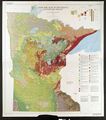|
|
| (5 intermediate revisions by the same user not shown) |
| Line 1: |
Line 1: |
| '''Canada''' (Listeni/ˈkænədə/; French: [ka.na.da]) is a country in the northern part of North America. | | [[File:O_Canada.png|thumb|Oh Canada.]]'''Canada''' is a country in the northern part of North America. |
|
| |
|
| == Description ==
| | Canada's ten provinces and three territories extend from the Atlantic to the Pacific and northward into the Arctic Ocean, covering 9.98 million square kilometres (3.85 million square miles), making it the world's second-largest country by total area and the fourth-largest country by land area. |
|
| |
|
| Canada's ten provinces and three territories extend from the Atlantic to the Pacific and northward into the Arctic Ocean, covering 9.98 million square kilometres (3.85 million square miles), making it the world's second-largest country by total area and the fourth-largest country by land area. Canada's border with the United States is the world's longest land border. Canada is sparsely populated, the majority of its land territory being dominated by forest and tundra and the Rocky Mountains; about four-fifths of the country's population of 35 million people live near the southern border. The majority of Canada has a cold or severely cold winter climate, but southerly areas are warm in summer.
| | Canada's border with the United States is the world's longest land border. |
|
| |
|
| The land now called Canada has been inhabited for millennia by various Aboriginal peoples. Beginning in the 15th century, British and French colonies were established on the Atlantic coast, with the first establishment of a region called "Canada" occurring in 1537. As a consequence of various conflicts, the United Kingdom gained and lost territories within British North America until left, in the late 18th century, with what mostly geographically comprises Canada today. Pursuant to the British North America Act, on July 1, 1867, the colonies of Canada, New Brunswick, and Nova Scotia joined to form the autonomous federal Dominion of Canada. This began an accretion of provinces and territories to the self-governing Dominion to the present ten provinces and three territories forming modern Canada. In 1931, Canada achieved near total independence from the United Kingdom with the Statute of Westminster 1931, and full sovereignty was attained when the Canada Act 1982 removed the last remaining ties of legal dependence on the British parliament.
| | Canada is sparsely populated, the majority of its land territory being dominated by forest and tundra and the Rocky Mountains; about four-fifths of the country's population of 35 million people live near the southern border. |
|
| |
|
| Canada is a federal parliamentary democracy and a constitutional monarchy, with Queen Elizabeth II being the head of state. The country is officially bilingual at federal level. It is one of the world's most ethnically diverse and multicultural nations, the product of large-scale immigration from many countries. Its advanced economy is the eleventh largest in the world, relying chiefly upon its abundant natural resources and well-developed international trade networks. Canada's long and complex relationship with the United States has had a significant impact on its economy and culture.
| | The majority of Canada has a cold or severely cold winter climate, but southerly areas are warm in summer. |
| Canada is a developed country and has the tenth highest nominal per capita income globally, and the ninth highest ranking in the Human Development Index. It ranks among the highest in international measurements of government transparency, civil liberties, quality of life, economic freedom, and education. Canada is a Commonwealth Realm member of the Commonwealth of Nations, a member of the Francophonie, and part of several major international and intergovernmental institutions or groupings including the United Nations, the North Atlantic Treaty Organization, the G8, the Group of Ten, the G20, the North American Free Trade Agreement and the Asia-Pacific Economic Cooperation forum.
| |
|
| |
|
| == Nonfiction cross-reference == | | == In the News == |
| | |
| | <gallery> |
| | File:Minnesota Quaternary geologic map.jpg|link=Minnesota (nonfiction)|[[Minnesota (nonfiction)|Minnesota]], Canada's neighbor to the South. |
| | </gallery> |
|
| |
|
| == Fiction cross-reference == | | == Fiction cross-reference == |
|
| |
|
| * [[New Minneapolis, Canada]] | | * [[New Minneapolis, Canada]] |
| | |
| | == Nonfiction cross-reference == |
| | |
| | * [[Minneapolis (nonfiction)]] |
| | * [[Minnesota (nonfiction)]] |
|
| |
|
| == External links == | | == External links == |
| Line 24: |
Line 32: |
|
| |
|
| [[Category:Nonfiction (nonfiction)]] | | [[Category:Nonfiction (nonfiction)]] |
| | [[Category:Canada (nonfiction)]] |
| [[Category:Countries (nonfiction)]] | | [[Category:Countries (nonfiction)]] |
Canada is a country in the northern part of North America.
Canada's ten provinces and three territories extend from the Atlantic to the Pacific and northward into the Arctic Ocean, covering 9.98 million square kilometres (3.85 million square miles), making it the world's second-largest country by total area and the fourth-largest country by land area.
Canada's border with the United States is the world's longest land border.
Canada is sparsely populated, the majority of its land territory being dominated by forest and tundra and the Rocky Mountains; about four-fifths of the country's population of 35 million people live near the southern border.
The majority of Canada has a cold or severely cold winter climate, but southerly areas are warm in summer.
In the News
Fiction cross-reference
Nonfiction cross-reference
External links

